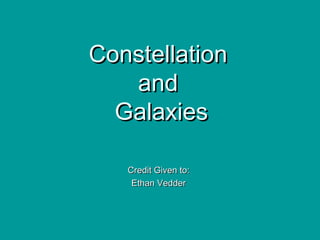
Constellations and galaxies 2013
- 1. Constellation and Galaxies Credit Given to: Ethan Vedder
- 2. Describe in writing (a few words) at least 10 different things going on in this painting A tree The Twins A boat The watcher A playful man The A girl playing mother A woman A shy fishing A married man A puzzling The sisters couple girl The thief The monkey? A man smoking The big dog The running dog
- 5. Constellations Greek, Arab, Egyptian, and Babylonian constellations 88 major ones (you don’t have to know all of them) North Circumpolar Winter, spring, summer, fall constellations Remember, these stars are only for the Northern Hemisphere
- 9. Galaxies A large-scale group of stars 100,000 light years across from one side to the other 100-400 billion stars per galaxy Thought to be between 50 billion and 1 trillion galaxies Quick math: 5,000,000,000,000,000,000 to 400,000,000,000,000,000,000 stars out there (5x1018-4x1020)
- 10. Galaxies Contain gas and dust (nebulae) Brought together by gravity Bright and dark nebulae “Local Group”: the 17 galaxies within 3 million light years of the Milky Way Closest neighbors: Large and Small Magellanic Clouds (a mere 150,000 light years away)
- 11. Types: Spiral galaxies Elliptical galaxies Irregular galaxies Huge; contain stars, Huge; contain stars, Huge; contain stars, gas, and dust gas, and dust gas, and dust Held together by gravity Held together by gravity Held together by gravity Pinwheel shape (see Round-to-oval shape No regular shape top view of Spiral 1, above) Bulge and thin disk; Bulge but no disk; halo May show signs of a halo is present (see is present disk and/or a bulge; side view of Spiral 2, halo is present above) Rich in gas and dust Little cool gas and dust Usually rich in gas and dust Young and old stars are Mainly old stars are Young and old stars are present present present http://amazing-space.stsci.edu/resources/organizers/galaxy.php.p=Astronomy+basics@eds.astronomy-basics.php
- 12. Spiral Galaxies Looks like a flattened disc Has a bulge/nucleus in the middle and spiral arms on the outside Spiral arms contain dust and gas and young stars Spiral (Sa, Sb, Sc) and, Barred Spiral (SBa, SBb, SBc) Ex. The Milky Way Galaxy A barred spiral galaxy
- 13. Spiral Galaxy (Sa-Sc) The Whirlpool Galaxy and its companion http://en.wikipedia.org/wiki/Image:Messier51_sRGB.jpg
- 14. Barred Spiral Galaxy (SBa- SBc) There is a straight “bar” at the beginning of the galactic arms http://www.news.wisc.edu/newsphotos/images/Milky_Way_galaxy_sun05.jpg
- 15. Elliptical Galaxies Do not have “arms”, instead look like ellipses (flattened spheres) Symbols: E0-E7 10-15% of known galaxies Are typically older stars and in the center of globular clusters No gas and dust (likely the dust has been used, collected, or blown away by the stars already)
- 16. Elliptical Galaxies (E0-E7) http://cseligman.com/text/stars/ http://csep10.phys.utk.edu/as messiergalaxies.htm tr162/lect/galaxies/m87.gif
- 17. Irregular Galaxies These do not fit into spiral or elliptical galaxy descriptions Believed to be spiral or elliptical galaxies that were altered or distorted by gravity Or galaxies that were too small to organize themselves Generally small and faint 25% of all galaxies
- 18. Computer models vs Hubble Pictures
- 19. Irregular Galaxies http://starchild.gsfc.nasa.g ov/Images/StarChild/unive rse_level2/ngc6822.gif http://en.wikipedia.org/wiki/Image:G alaxyNGC1427A_HubbleImage.jpg
- 21. The Milky Way Galaxy (us!) We are located on a spiral arm About 2/3 of the way out from the center 100,000 light years across
- 22. Star groups Stars are more often found in groups than by themselves We’re in the minority Open and Globular clusters Open = less, loose, galactic arms Globular = more, spherical, center Binary and triple star systems Revolve around each other
- 23. Quasars Some of the earliest things produced from the big bang 13.7 billion years ago “Appear to be a faint small star” with the energy output much brighter than the brightest galaxies… Howcan something be so small and produce so much energy?
- 24. Star Journal Homework Go outside on a dark night with no clouds Find a safe place that is pretty dark (behind your house, a deck) Stay there for 10 minutes, but DO NOT look at any bright lights Answer the questions on the assignment sheet
Hinweis der Redaktion
- http://amazing-space.stsci.edu/resources/organizers/galaxy.php.p=Astronomy+basics@eds.astronomy-basics.php
